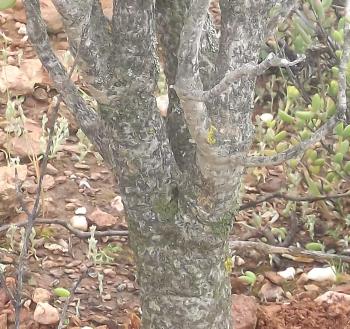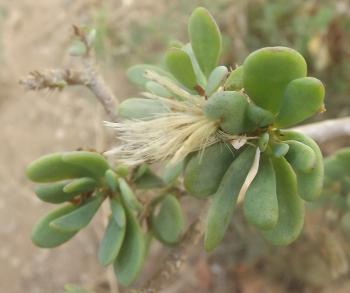Othonna arbuscula
Othonna arbuscula (Thunb.) Sch.Bip.
Family: Asteraceae
Common names: bonsai othonna (Eng.); knolharpuis, knolrepuis,nu-nu, traap (Afr.)
SA Tree No: 740
Introduction
A small succulent shrub from the arid areas of southern Africa, which has the appearance of a small tree or bonsai.

Description
Description
Othonna arbuscula is a deciduous, perennial, succulent shrub, with a rounded crown, that grows between 0.5–1 m high. It is divided into 2- or 3-branched, fleshy stems, enfolded in a beige, thin layer of bark. Leaves are grey, oblanceolate, sometimes coarsely toothed and are up to 15 mm long.

Flowers are bright yellow, in 1 or 2 discoid heads, at branch tips and on short peduncles. Othonna arbuscula flowers in winter and loses it leaves during the summer months. This plant also has a shallow root system for easy water uptake.
Conservation Status
Status
According to the Red List of South African Plants, this species is assessed as Least Concern (LC), it has a stable population and is not threatened.
Distribution and habitat
Distribution description
Othonna arbuscula occurs on rocky slopes with clay soil, in the Richtersveld, Namaqualand klipkoppe, Knersvlakte, and also southwards into the Western Cape and the Robertson Karoo area.
The genus consists of about 100 or more species. Most of them are from the winter rainfall areas. Othonna is native to South Africa in the Western Cape and Namaqualand, some species also grow in Namibia and East Africa.

Derivation of name and historical aspects
History
The genus Othonna was derived from an ancient Greek word, othonne, meaning ‘linen’ or ‘cloth’. The meaning of this name probably derives from the soft characteristics of the leaves of some of the species in this genus. The species name arbuscula is Latin, and means ‘like a small or dwarf tree’.
Ecology
Ecology
Othonna arbuscula is adapted to arid areas, with a clay-loam soil structure and mostly occurs on steep hillsides, but can grow on lower slopes as well. The leaves and stems are fleshy due to the hot and dry conditions that it is exposed to. This plant also has a shallow root system for easy water uptake. Flowers are possibly pollinated by bees or beetles. Seed dispersal is aided by the bristle-like structures attached to the seed, called the pappus, that is easily blown by wind.

Uses
Use
Othonna arbuscula stems produce resin that is used to combat colds, flu, headaches, colic, and it is even used as ointment to treat cancer. It has also been used since ancient times, by the Khoisan people as an odorant.
Growing Othonna arbuscula
Grow
Othonna arbuscula grows well in full sun, in low rainfall areas, is also drought tolerant and is well suited to arid gardens. It makes a perfect feature in pots, as well as in a rockery landscape. This plant can also be used as a water-wise plant or miniature bonsai tree. Companion plants include: Cotyledon orbiculata, Ruschia caroli, Pteronia paniculata and P. incana, Othonna retrofracta, Aloe microstigma and Drimia capensis.
Propagation by cuttings is unknown because it is easily grown from seed. Harvest seed during early summer (October and November) and sow in autumn (March–May). Use a well-drained soil mixture of 50% coarse river sand and 50% sieved compost. Sow seeds on top of the soil mixture and cover with sieved coarse river sand. Seeds will germinate very easily within 2 weeks. Keep medium well moist. Seedlings need to be transplanted in a suitable potting medium.
References
- Le Roux, A. 2005. Namaqualand. South African Wild Flower Guide 1. Botanical Society of South Africa, Cape Town.
- Rowley, G.D. 1980. Name that succulent. Stanley Thornes Publishers, Cheltenham.
- Smith, G.F. & Van Wyk, B-E. 2008. Garden succulents. Briza Publications, Pretoria.
- Manning, J. & Goldblatt, P. 2012. Plants of the Greater Cape Floristic Region 1: the Core Cape Flora. Strelitzia 29. South African National Biodiversity Institute, Pretoria.
- Smith, C.A. 1966. Common names of South African plants. Memoirs of the Botanical Survey of South Africa No. 35. Government Printer, Pretoria.
Credits
Amahle Tshetsha and Ricardo Riddles
Karoo Desert National Botanical Garden
August 2016
Plant Attributes:
Plant Type: Shrub, Succulent
SA Distribution: North West, Northern Cape, Western Cape
Soil type: Sandy, Clay
Flowering season: Spring
PH: Acid
Flower colour: Yellow
Aspect: Full Sun
Gardening skill: Easy
Special Features:
Horticultural zones








Rate this article
Article well written and informative
Rate this plant
Is this an interesting plant?
Login to add your Comment
Back to topNot registered yet? Click here to register.